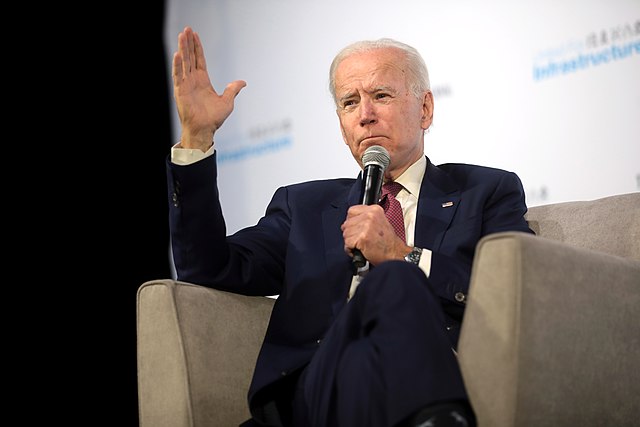- 14 3402-5578
- Rua Hygino Muzy Filho, 737, MARÍLIA - SP
- contato@latinoobservatory.org
 Foto: Gage Skidmore from Surprise, AZ, United States of America
Foto: Gage Skidmore from Surprise, AZ, United States of America
On August 24, 2022, US President Joe Biden announced a project to write off the student debt of millions of UScitizens. It was an expected measure, as it was a campaign proposal that mobilized millions of students during his 2020 campaign. The volume of student debt in the United States is close to $1.7 trillion, something similar to the Gross Domestic Product (GDP) of Brazil, calculated at US$ 1.92 trillion for last year.
During the period of Donald Trump, the US government suspended debt payments in March 2020 due to the financial crisis caused by the pandemic. The measure was extended a few times and payment was expected to be returned in May 2022. Despite this, 93% of borrowers declared in a survey, carried out by the Student Debt Crisis Center, who did not feel prepared for the return of the payment.
The federal student loan was created in 1958 and is most advantageous for students who can wait until the middle of the course to start paying. With the advent of neoliberalism, governments stopped supporting higher education and access to university became almost exclusively through the payment of tuition fees. In addition, the value of the installments rose meteorically, leaving many students in debt, since the jobs they got after college were not well paid enough to meet the educational investment.
In the last three decades, the average amount of debt has tripled, going from US$ 10,000 to US$ 30,000, according to data released. This is a problem that afflicts a significant portion of the population, as student debt cannot be subject to bankruptcy. In some cases, debts are bequeathed to the debtor's children in view of the difficulty of honoring payment. The 2014 film “Ivory Tower”, directed by Andrew Rossi, represents part of this drama.
Thus, the issue of student debt relief
has become quite popular in the United States, where nearly 44 million people
are indebted. In 2020, according to the Medium portal,
Joe Biden promised to forgive a significant part of the egress debt:
“(...) I directed my team to develop a plan to forgive federal student debt related to the cost of tuition currently held by low-income and middle-class people for public undergraduate colleges and universities, as well as historically black private colleges and universities (HBCUs) and private and underfunded Minority Care Institutions (MSIs). The concept I am announcing today will align my student debt relief proposal with my future college tuition proposal. Pursuant to that plan, I propose to forgive all federal debt related to two-year and four-year public college and university undergraduate tuition for debt holders earning up to $125,000, with appropriate eliminations to avoid a cliff.”
In addition to rising debt, Americans are also suffering from inflation in the country, which has been eroding wages for the past two years. Thus, purchasing power decreased, leading those already indebted to accumulate more debt. Another result of this was the decrease in students enrolled in higher education, which dropped 5.1% in 2022 - a loss of almost one million students.
Student indebtedness exceeds the value of debts with car financing and credit cards, lagging behind real estate financing. The Federal Reserve points out that these loans combine, that is, it is common for people to accumulate more than one debt, further aggravating the situation of American students.
Evidently, this major obstacle in the lives of American college graduates is not a problem that started recently. It results from a historical process of commodification of education in the country, making it one more item on the market and aggravating social inequality in the USA. Therefore, to achieve prestige and knowledge, the lower classes need to acquire large loans, assuming debts even before having an income. This is a problem that is becoming a snowball, especially among graduates of local universities and colleges and in careers that offer no financial gain compared to computer engineering or medicine. Those who earn their degrees at renowned elite universities generally do not face this problem.
To try to alleviate the situation, President Joe Biden announced in August 2022 the forgiveness of student debts. Borrowers earning less than $125,000 a year would have $10,000 forgiven, and low-income students who are part of the Pell Grants program, the federal government's grant program, could receive up to $20,000 in debt forgiveness.
The measure was the target of criticism in the United States and raised concern about the economic impact it could generate. In the long term, forgiveness could generate a loss of US$ 60 billion per year just with the interest that would no longer be collected, as disclosed by the Valor Investe website. Furthermore, the US government would need to pay investors who hold US Treasuries $28 billion a year.
Despite the numbers seem high, the estimate is that Biden's plan will not impact the economy so sharply. Debt forgiveness was scheduled for January 2023, being combined with the suspension of the moratorium on student debt payments. Mark Zandi, chief economist at Moody's Analytics, told CNN that “the end of the moratorium will weigh on growth and inflation, while debt forgiveness will support growth and inflation”, thus, a good part of the impacts of the announced measures would be reduced and almost non-existent.
Also according to the chief economist at Moody's, the impact of the plans announced by Joe Biden would be a decrease of 0.05 percentage points in the US GDP, a reduction in unemployment by 0.02 percentage points and 0.03 percentage points in inflation. That is, all impacts would be less than 1 percentage point, therefore, they would have a low real effect on the US economy.
On the other hand, the measure could ease the bills of millions of US borrowers, even if it does not solve the entire student debt problem in the United States. Debt forgiveness could alleviate the accounts of 43 million people, with 20 million having their remaining balance zeroed out. Despite this, Biden's plan is seen by some segments as insufficient for not eliminating the underlying problems of the student debt crisis.
Some progressive groups have called for the elimination of up to $50,000 in debt. Thus, although the measure is necessary, it is still seen as timid by these groups in view of the size of the problem. In addition to the timidity of the measure, the issue of student debt does not end there. US university tuition fees remain high and are expected to continue rising, mainly due to inflation. That is, the main problem continues and, even if the debts are reduced, the problem can return in the long run and become even bigger.
Former Treasury Secretary Larry Summers said: “The costs are out of control. It is absurd that people have to borrow large sums of money and then struggle to pay them back”, and added: “This problem is not solved”. He also warned that solving part of the problem could increase university fees, increasing the debt of students seeking higher education and contributing to the worsening of social inequality in the country.
From another perspective, the deputy of Mexican descent, Tony Cárdenas, defended Joe Biden's measure and participated in meetings at the White House to negotiate the forgiveness of debts. The politician stated that “many young people will breathe a sigh of relief, they will be able to buy a house soon. They can make plans to start a family sooner.” As well as Cárdenas, other members of the Latin bench put pressure on the president for the decision to be taken. He also argued that such a plan would be needed to pivot ahead of the US midterm elections that took place in November 2022.
However, in October 2022, the US Court of Appeals for the 8th Circuit decided to temporarily block the pardon. The court covers the territories of Nebraska, Missouri, Arkansas, Iowa, Kansas and South Carolina, all headed by Republican politicians. Subsequently, in November 2022, Texas Judge Mark T. Pittman stated that the program is illegal and should be terminated.
In early December 2022, the US 5th Circuit Court of Appeals, based in New Orleans (which covers the states of Texas, Mississippi and Louisiana) also rejected the appeal request that the government had made, upholding the decision that makes Joe Biden's debt relief illegal. Thus, the US government appealed to the last instance of the judiciary, the Supreme Court of the United States, to suspend the decisions taken by the regional courts.
Recently, in February 2023, the United States Supreme Court challenged Joe Biden's decision in a session of the body. The judges on the court, mostly conservatives, used oral arguments to discuss whether the US president would have the legal authority to make that decision. According to an argument raised by the members of the court, the Executive would need the approval of the Legislative for this measure, since it would affect economic and political issues in the country, therefore, it should respect the “doctrine of the main issues”, provided for in the US Constitution.
Represented by the US Attorney General, Elizabeth Prelogar, the US federal government stated that the decision could be supported by the law sanctioned in 2003, “Heroes Act”. Under the law, the secretary would have the authority to take action to alleviate student debt in the event of a national emergency, preventing borrowers from being worse off in debt.
While US bodies are discussing the legality of the measure, millions of students are still sunk in the debts they assumed to access higher education. Even if the US federal government's plan goes ahead, the student debt problem will continue to exist and contribute to blocking people's access to the university system.
For now, any measure could represent relief for the millions of students who are in debt. Mainly, considering that even a timid measure in view of the size of the problem still faces a lot of criticism and resistance within the US system, and may even be left aside and not materialize.
Discussing this issue is very important, as in addition to indicating a very serious problem in US society, it also shows the political paralysis in taking measures that can effectively resolve the most burning issues in the country. It is noted that the political polarization in Congress restricts the search for solutions. The current design of representation in the Senate, for example, practically prevents any decision that implies a qualified majority, as it is not on the horizon that Democrats or Republicans can reach 60 senators.
In addition, the Supreme Court has become a major obstacle to any social or progressive policy. In advance, it is already expected that the majority of judges appointed by Republicans will block the initiatives of a Democratic president. This has already happened with immigration policy, with abortion rights, with ownership of weapons and regarding environmental policies. The eminently legal or constitutional question is relegated to the background.











